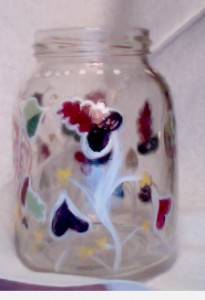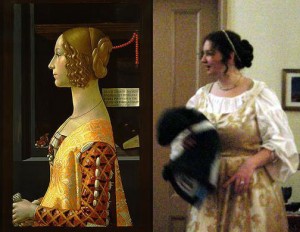I recently was thinking of stuff I did long ago, and if it could apply to my medieval bent. I remembered being in Chicago at the Art Institute last year, where I saw some medieval and Renaissance painted glass beakers from Germany and Italy. I thought of how I had painted things on glass (I once even had a paying commission for two martini glasses with a whimsical city theme!) But mostly I painted silly things for my own amusement – very happy root vegetables, rabbits, birds on phone wires….
But today at the craft store there were glass paints on clearance so I bought them, and sat down tonight with some pictures to inspire me, and here’s what I got from tonight’s try of a long-forgotten thing. I am pretty clumsy and have forgotten the nice ratios I used to have to thin the enamel, but hey, there it is….
I used the Aldrevandini beaker in the British Museum collection as my inspiration, since it’s mostly leaves, frankly, and not finely detailed pictures of people doing something fun or useful. I think I can almost handle leaves. A photo of it is at the bottom.





This is the piece which was the inspiration for the work. It’s obviously a totally different style of glass, not a jam jar, and it really shows that I need to thin out the enamel somewhat to get a finer line to work with, but overall, I think it’s not the worst start of things, given the last time I picked up a paint brush.

More to come, surely.


